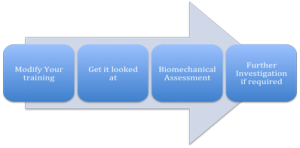
Calf pain is a very common problem amongst runners, and if not managed properly can become a chronic and debilitating recurring condition.
Basic Anatomy
The calf is made up of two main muscles, your gastrocnemius and soleus muscles. Both of these muscles control ankle movement, but only the gastrocnemius works in the knee too. However, there is often more to ongoing calf pain than can be explained purely by injury or malfunction of these muscles. The calf has many smaller muscles, nerves and joints that can be very influential in its ongoing pain.
Below are some of the causes seen in clinic.
| Common Causes | Less Likely | Rare |
| Muscle strain | Stress fractures of the tibia and fibula | DVT |
| Muscle contusions | Artery entrapment | |
| Cramps | Compartment syndrome | |
| Shin Splints | ||
| Referred pain | ||
| Tibial Stress syndrome |
In relation to running, you must consider the simple causes of pain first. A sudden increase in speed may be all it takes to overload the calf muscle tissue causing a strain or even tearing the muscle belly. This could be a ‘one off’ injury that will get better quickly, but it is likely to need rehabilitation of some kind. If the pain does not improve or gets worse, careful consideration of all the factors that may be driving the pain is needed.
Below is a table of likely causes of calf pain.
| Possible Causes of Calf Pain |
| Poor running biomechanics |
| Training errors |
| Inappropriate footwear |
| Poor conditioning |
| Muscle tightness and imbalance |
| Diet and fluid intake issues |
The most influential cause of calf pain is poor biomechanics. This has been well documented in many studies over the years. For example a cross over running style is known to cause excessive pronation of the foot, which will in turn; increase the stress on the soleus muscle and also on the tibia. Failure to address this can easily lead to pain severe enough to impact on your training and inevitably your performance.
In my experience however, a very common cause is the competitor’s failure to structure their training properly. With the marathon only weeks away now people will be increasing the amount of training they are doing (increasing distance and regularity of runs). Ramping up your distance too quickly will almost certainly lead to injury of some description. Like your cardiovascular fitness, your muscles and joints need time to develop the strength required to absorb the stresses associated with running.
What can be done about it?
If your pain does not subside, the first thing you should do is think about any possible changes that could have caused it. Remember, you know your body better than anyone else, so any information you provide is greatly important. Follow some simple steps early on and you should be fine.
1) Modify your activity
Depending on the severity of your pain/injury; you may need to take a break from running. Remember that the calf is the powerhouse of any runner’s leg, so injuries should always be given a healthy amount of respect. Just because you are injured, there is no reason why your fitness should suffer, so view this stage as an opportunity to develop other types of fitness. I always recommend cross training. For example, the static bike, rower, Xtrainers and swimming all hit your heart and lungs hard without the impact of running.
2) Get it looked at
A thorough Physiotherapy assessment will aim to find the cause of your symptoms. From here a focused rehabilitation program with manual therapy will help calm your symptoms and prevent them from returning. There are many treatment techniques that can help, but an individually tailored assessment will highlight the best ones for you.
3) Self Help
Your physio may employ the use of massage techniques to help with your symptoms. This is something that you can also complete at home or at the gym with the aid of foam rollers, spiky balls and other massage aids.
4) Biomechanical Assessment
Biomechanical assessments are great at providing information as to why your pain is not improving. It could be that an orthotic could help improve the way impact forces are absorbed by your feet and joints higher up your leg. This is very important, and I would go as far to say that anyone thinking of taking up running or significantly increasing their distance should consider this type of assessment to screen any potential problems before they happen.
Summary
Calf pain should not persist and should not hamper your training. If you feel pain (that may or may not have an instant explanation) act fast and wisely. Do not try to just run through the pain. The faster you act on it the quicker the resolution and the quicker you will be back running.




